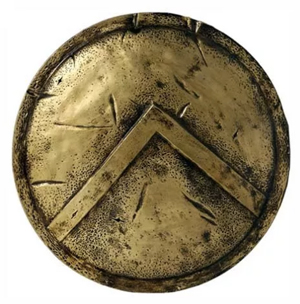
In his left hand the hoplite carried the aspis, a heavy wooden shield measuring around one metre in diameter. The spears used in Alexander the Great’s Macedonian phalanx were even longer: 13–21 feet. This was eight feet of iron-tipped brutality, with a deadly blade at the top end and a spike at the bottom end, which acted as a counter-weight and a secondary killer. Hoplites went into battle carrying a long spear called a dory. From the eighth or seventh century BC, hoplites started fighting in the phalanx, a formation that helped them achieve a string of notable victories over the Persians, such as the triumph at Marathon in 490 BC.
#ANCIENT GREECE HOPLITE SHIELD PROFESSIONAL#
The hoplites were not professional soldiers but primarily free citizens (often farmers and artisans) able to afford linen and bronze armour. When the Greek city-states went to war, it was the hoplites who formed the backbone of their armies. Hoplites and the phalanx: the footsoldiers of ancient Greek armies For all their military acumen, the Spartans’ spell at the top table of Greek powers was to be short-lived. Just over 30 years later, the Thebans invaded the region of Laconia and freed many of the helots. In 404 BC, the Spartans used their martial prowess to unseat Athens as the dominant power in the Greek world at the climax of the Peloponnesian War. Such courage earned them a place in history: 300 Spartans were famously among those who fought against a massive Persian army at the battle of Thermopylae. This unstinting dedication to war made the Spartans feared opponents, famed for their bravery. They were expected to keep physically fit, while mothers reportedly told their sons before they left for battle, “Come back with your shield, or on it.” Women, too, bought into the warrior ethos. Worse still, they were often encouraged to mistreat the helots, Sparta’s slave class. This mantra was reflected in the austere nature of their training: they were subjected to continuous (often violent) competitions, given meagre food rations, and encouraged to steal food in order to prepare themselves for life in a warzone.

At the tender age of seven, boys were plucked from their families and entered into a 23-year military training regime designed to turn them into consummate warriors.įrom the outset, the trainee fighters were taught that loyalty to their city should always take precedence over self-preservation. Sparta was a true warrior-society, as men discovered at the earliest of ages. But only one lived and breathed martial prowess, and that was Sparta. The Spartan war machineĪll Greek city-states took their military seriously. Greek warfare would now be exported across the known world – with history-shaping consequences. These included the trireme, the galley that helped Athens rule the waves in the fifth century BC, and the fearsome Macedonian phalanx.īy the end of the Classical period, Alexander the Great was using these advances to turn the tables on the Persians and forge an enormous empire. Just as Classical Greece saw enormous leaps forward in politics and culture, so it also witnessed advances in military technologies.


 0 kommentar(er)
0 kommentar(er)
